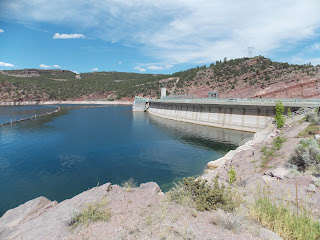We had a most interesting day yesterday and it did not end well, as we nearly got swallowed up in the back country of Wyoming! More on that later. North of Rock Springs is a corral for wild horses. Outside of the coral is a shelter whereby visitors can view them and also receive information regarding the horses presence in the West and how to adopt them. There are over 40,000 free-roaming horses and burros through out western states, and over 200 herd management areas administered primarily by the Bureau of Land Management. When the herds increase and there is limited vegetation and water to sustain the animals it then becomes necessary for the BLM to round them up. The horses are descendants of the horses brought over by Spanish explorers in the 16th century, so technically they are described as feral. Many people refer to them as mustangs, which is Americanized slang for the Spanish word mesteno, or "stray".
One panel of the petroglyphs is pictured above. It is of some antlered animal, other pictures depict buffalo, and human stick figures. Possibly in the above picture there is also a boar below the deer or elk. Anthropologists estimate that the drawings were done about 200 to as much as 1,000 years ago.
We traveled further on the dirt road, following signs to the sand dunes, pictured above. The dunes may reach as 100 feet high, and are over 70 miles long. The last must-see on John's list was the Boar's Tusk.
This rock formation, which holds great religious importance to Native Americans in the area, rises 400 feet off the desert floor. It is a core of an ancient volcano. Returning to Rock Springs, John decided to take a short-cut back to town, our first mistake. Shortly after that we got into a hard rain, and had trouble seeing the road. The road came to a fork- we took the higher road thinking we were better off on high ground. That was our next mistake as it was a sand-pack road into which our tires rapidly sank. We called AAA, and were told that there was only one tow truck in the area and the driver was not answering his phone. We tried digging ourselves out with a frisbee, a garden trowel and John's walking stick. I have not had my hand in so much sand since my childhood! It was cool and moist, I did not mind ( I found out later however, once I washed my hands, that it was quite dirty). Eventually we just sat in the car, we were fortunate that the rain brought the desert temperature down. We had food and lots of water- and I had a book. We sat for several hours until a man and his family came along. They were in a camper truck and towed a trailer which held their dune buggy. They also had a nice chain which could be attached to the tow bar of our car. It was amazing how easy it was then for our car to rise up and over the packed sand piles! We were able to get back on the dirt road and arrived safely home after that. I fear that we did some damage to the under-carriage of the car, it dropped chunks of rock and sand all the way home and occasionally would make some weird noise. John thinks the noise is from the muffler. That was our fun day in the desert, hopefully not to be repeated again for a long time!




















































